University Counseling Case Study: Greg's Anxiety and Treatment Plan
VerifiedAdded on 2020/03/23
|13
|3158
|255
Case Study
AI Summary
This case study examines Greg, a 32-year-old man struggling with anxiety, stress, and social difficulties. The assignment delves into Greg's presenting issues, including feelings of stress, social anxiety, career dissatisfaction, and a lack of romantic relationships. It explores areas needing more information, such as the root causes of his anxiety and career goals. The case is formulated using the 5P model (Presenting problems, Predisposing factors, Precipitating factors, Perpectuating factors, Protective factors) to understand the origins of his difficulties. The study then discusses various treatment options, including pharmacological and psychological interventions, ultimately choosing Cognitive Behavioral Therapy (CBT) due to its cost-effectiveness and patient preference. A detailed CBT treatment plan is outlined, including weekly sessions, cognitive restructuring, and strategies to replace negative thoughts with positive ones. The study also acknowledges potential challenges in working with the client and discusses the evaluation of the intervention's effectiveness. The assignment concludes by highlighting the importance of making CBT a lifestyle change for lasting results.
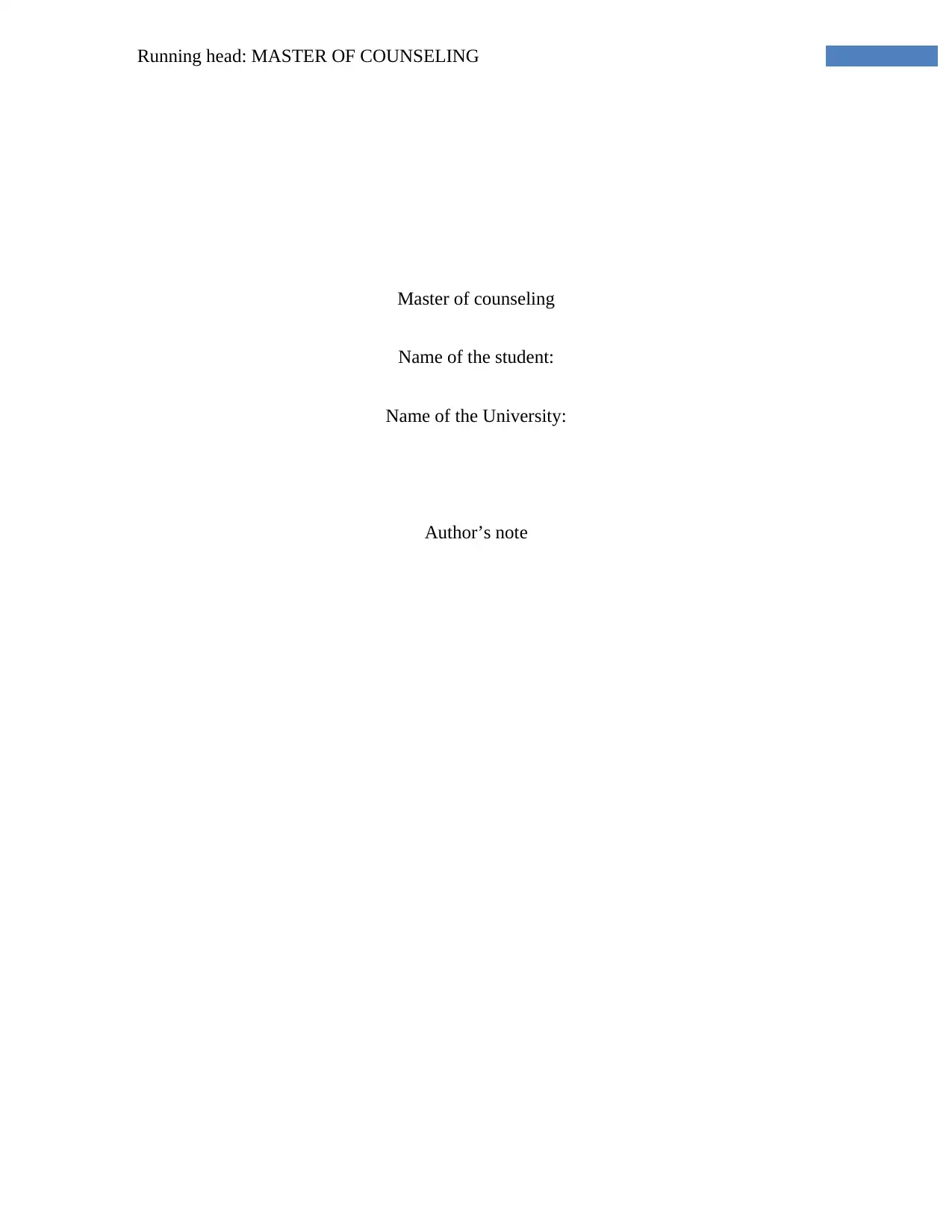
Running head: MASTER OF COUNSELING
Master of counseling
Name of the student:
Name of the University:
Author’s note
Master of counseling
Name of the student:
Name of the University:
Author’s note
Paraphrase This Document
Need a fresh take? Get an instant paraphrase of this document with our AI Paraphraser

1MASTER OF COUNSELING
Introduction:
The essay presents the cause of anxiety problem in people with the case formulation
using the 5P model for Greg. The major issue in Greg is feelings of anxiety and stress for a long
period of time and the identification of several factors behind the problem has helped to discuss
the best treatment options for Greg. The effectiveness of the treatment is determined with
support from relevant research literatures.
Presenting issues for Greg
The case study is about Greg, a 32 year old man with the following presenting issues:
Feelings of stress and anxiety:
Greg has been found to be suffering from anxiety since the past six months and currently
he has been attending counseling sessions to manage his feelings of anxiety. Till now, he has
attended three counseling sessions.
Anxious about socializing:
His feelings of stress and anxiety increase when he meets unfamiliar people. His heart
starts to beat rapidly. He is finding it difficult to cope with such situations. Hence, he tries to
escape such trouble either by leaving the place early or not socializing at all.
Affected by his father’s high expectation from his children:
Greg is of the opinion that his father, Terry has high expectations from his children.
Though Terry never scolded him, however Greg feels that his father gave a disappointed look
when he underperformed at school.
Introduction:
The essay presents the cause of anxiety problem in people with the case formulation
using the 5P model for Greg. The major issue in Greg is feelings of anxiety and stress for a long
period of time and the identification of several factors behind the problem has helped to discuss
the best treatment options for Greg. The effectiveness of the treatment is determined with
support from relevant research literatures.
Presenting issues for Greg
The case study is about Greg, a 32 year old man with the following presenting issues:
Feelings of stress and anxiety:
Greg has been found to be suffering from anxiety since the past six months and currently
he has been attending counseling sessions to manage his feelings of anxiety. Till now, he has
attended three counseling sessions.
Anxious about socializing:
His feelings of stress and anxiety increase when he meets unfamiliar people. His heart
starts to beat rapidly. He is finding it difficult to cope with such situations. Hence, he tries to
escape such trouble either by leaving the place early or not socializing at all.
Affected by his father’s high expectation from his children:
Greg is of the opinion that his father, Terry has high expectations from his children.
Though Terry never scolded him, however Greg feels that his father gave a disappointed look
when he underperformed at school.
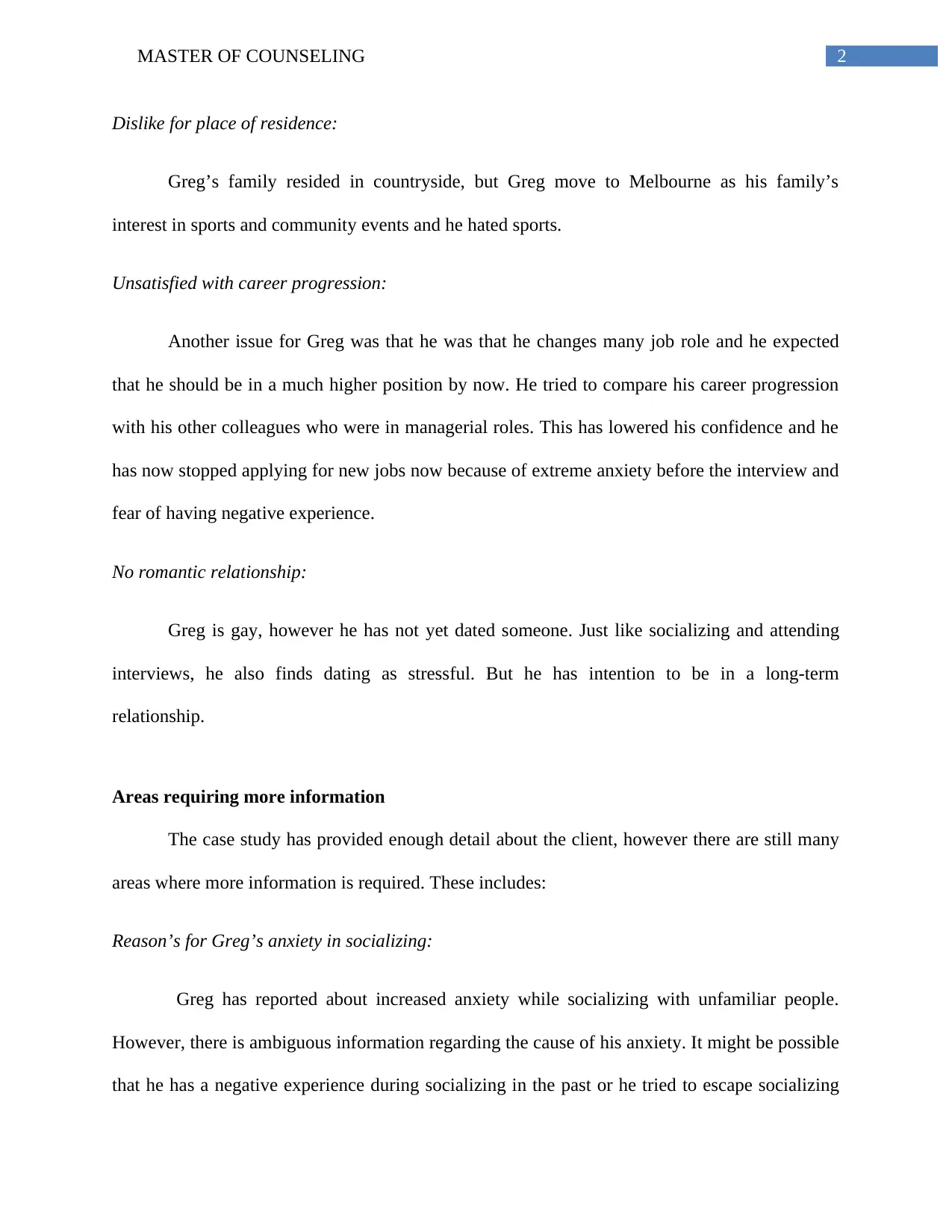
2MASTER OF COUNSELING
Dislike for place of residence:
Greg’s family resided in countryside, but Greg move to Melbourne as his family’s
interest in sports and community events and he hated sports.
Unsatisfied with career progression:
Another issue for Greg was that he was that he changes many job role and he expected
that he should be in a much higher position by now. He tried to compare his career progression
with his other colleagues who were in managerial roles. This has lowered his confidence and he
has now stopped applying for new jobs now because of extreme anxiety before the interview and
fear of having negative experience.
No romantic relationship:
Greg is gay, however he has not yet dated someone. Just like socializing and attending
interviews, he also finds dating as stressful. But he has intention to be in a long-term
relationship.
Areas requiring more information
The case study has provided enough detail about the client, however there are still many
areas where more information is required. These includes:
Reason’s for Greg’s anxiety in socializing:
Greg has reported about increased anxiety while socializing with unfamiliar people.
However, there is ambiguous information regarding the cause of his anxiety. It might be possible
that he has a negative experience during socializing in the past or he tried to escape socializing
Dislike for place of residence:
Greg’s family resided in countryside, but Greg move to Melbourne as his family’s
interest in sports and community events and he hated sports.
Unsatisfied with career progression:
Another issue for Greg was that he was that he changes many job role and he expected
that he should be in a much higher position by now. He tried to compare his career progression
with his other colleagues who were in managerial roles. This has lowered his confidence and he
has now stopped applying for new jobs now because of extreme anxiety before the interview and
fear of having negative experience.
No romantic relationship:
Greg is gay, however he has not yet dated someone. Just like socializing and attending
interviews, he also finds dating as stressful. But he has intention to be in a long-term
relationship.
Areas requiring more information
The case study has provided enough detail about the client, however there are still many
areas where more information is required. These includes:
Reason’s for Greg’s anxiety in socializing:
Greg has reported about increased anxiety while socializing with unfamiliar people.
However, there is ambiguous information regarding the cause of his anxiety. It might be possible
that he has a negative experience during socializing in the past or he tried to escape socializing
⊘ This is a preview!⊘
Do you want full access?
Subscribe today to unlock all pages.

Trusted by 1+ million students worldwide
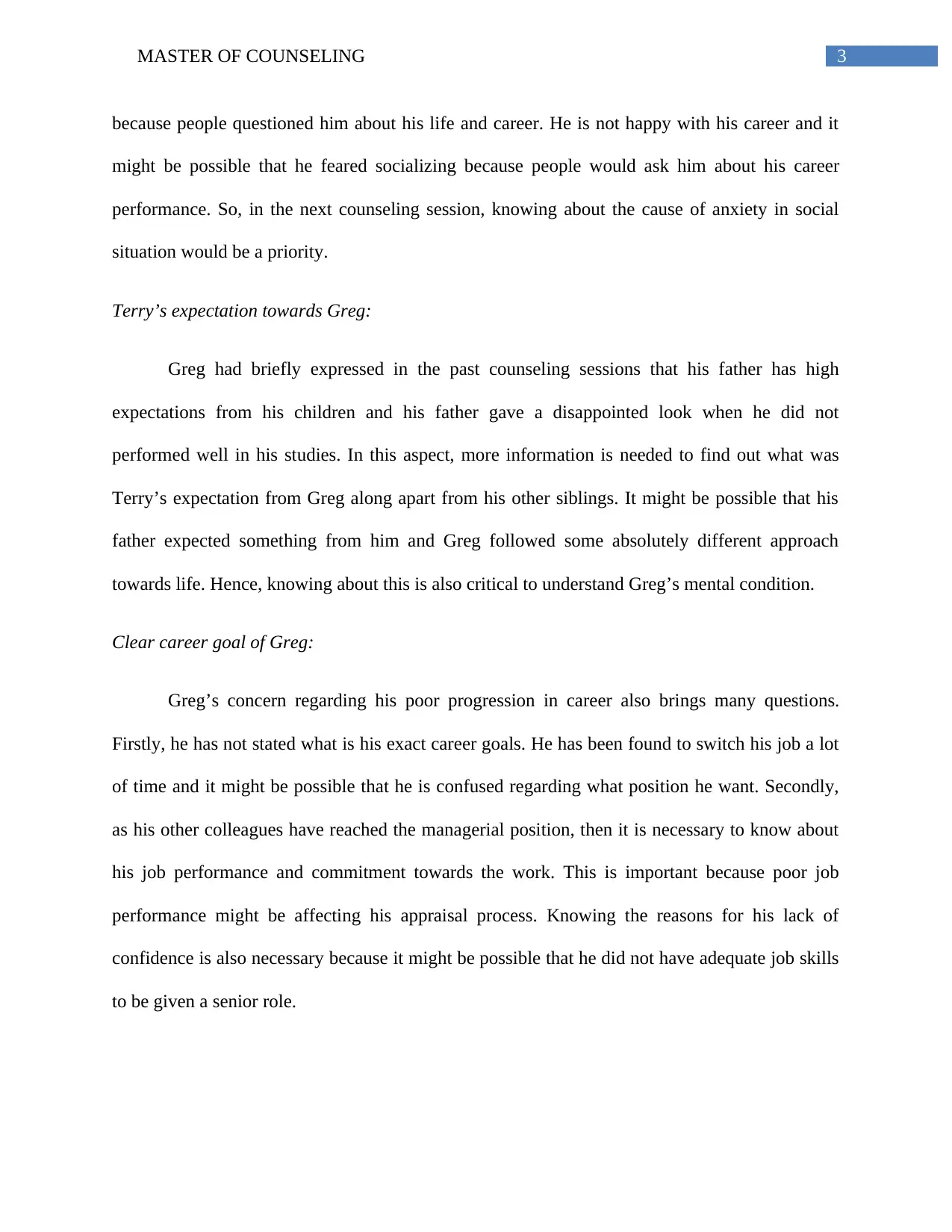
3MASTER OF COUNSELING
because people questioned him about his life and career. He is not happy with his career and it
might be possible that he feared socializing because people would ask him about his career
performance. So, in the next counseling session, knowing about the cause of anxiety in social
situation would be a priority.
Terry’s expectation towards Greg:
Greg had briefly expressed in the past counseling sessions that his father has high
expectations from his children and his father gave a disappointed look when he did not
performed well in his studies. In this aspect, more information is needed to find out what was
Terry’s expectation from Greg along apart from his other siblings. It might be possible that his
father expected something from him and Greg followed some absolutely different approach
towards life. Hence, knowing about this is also critical to understand Greg’s mental condition.
Clear career goal of Greg:
Greg’s concern regarding his poor progression in career also brings many questions.
Firstly, he has not stated what is his exact career goals. He has been found to switch his job a lot
of time and it might be possible that he is confused regarding what position he want. Secondly,
as his other colleagues have reached the managerial position, then it is necessary to know about
his job performance and commitment towards the work. This is important because poor job
performance might be affecting his appraisal process. Knowing the reasons for his lack of
confidence is also necessary because it might be possible that he did not have adequate job skills
to be given a senior role.
because people questioned him about his life and career. He is not happy with his career and it
might be possible that he feared socializing because people would ask him about his career
performance. So, in the next counseling session, knowing about the cause of anxiety in social
situation would be a priority.
Terry’s expectation towards Greg:
Greg had briefly expressed in the past counseling sessions that his father has high
expectations from his children and his father gave a disappointed look when he did not
performed well in his studies. In this aspect, more information is needed to find out what was
Terry’s expectation from Greg along apart from his other siblings. It might be possible that his
father expected something from him and Greg followed some absolutely different approach
towards life. Hence, knowing about this is also critical to understand Greg’s mental condition.
Clear career goal of Greg:
Greg’s concern regarding his poor progression in career also brings many questions.
Firstly, he has not stated what is his exact career goals. He has been found to switch his job a lot
of time and it might be possible that he is confused regarding what position he want. Secondly,
as his other colleagues have reached the managerial position, then it is necessary to know about
his job performance and commitment towards the work. This is important because poor job
performance might be affecting his appraisal process. Knowing the reasons for his lack of
confidence is also necessary because it might be possible that he did not have adequate job skills
to be given a senior role.
Paraphrase This Document
Need a fresh take? Get an instant paraphrase of this document with our AI Paraphraser
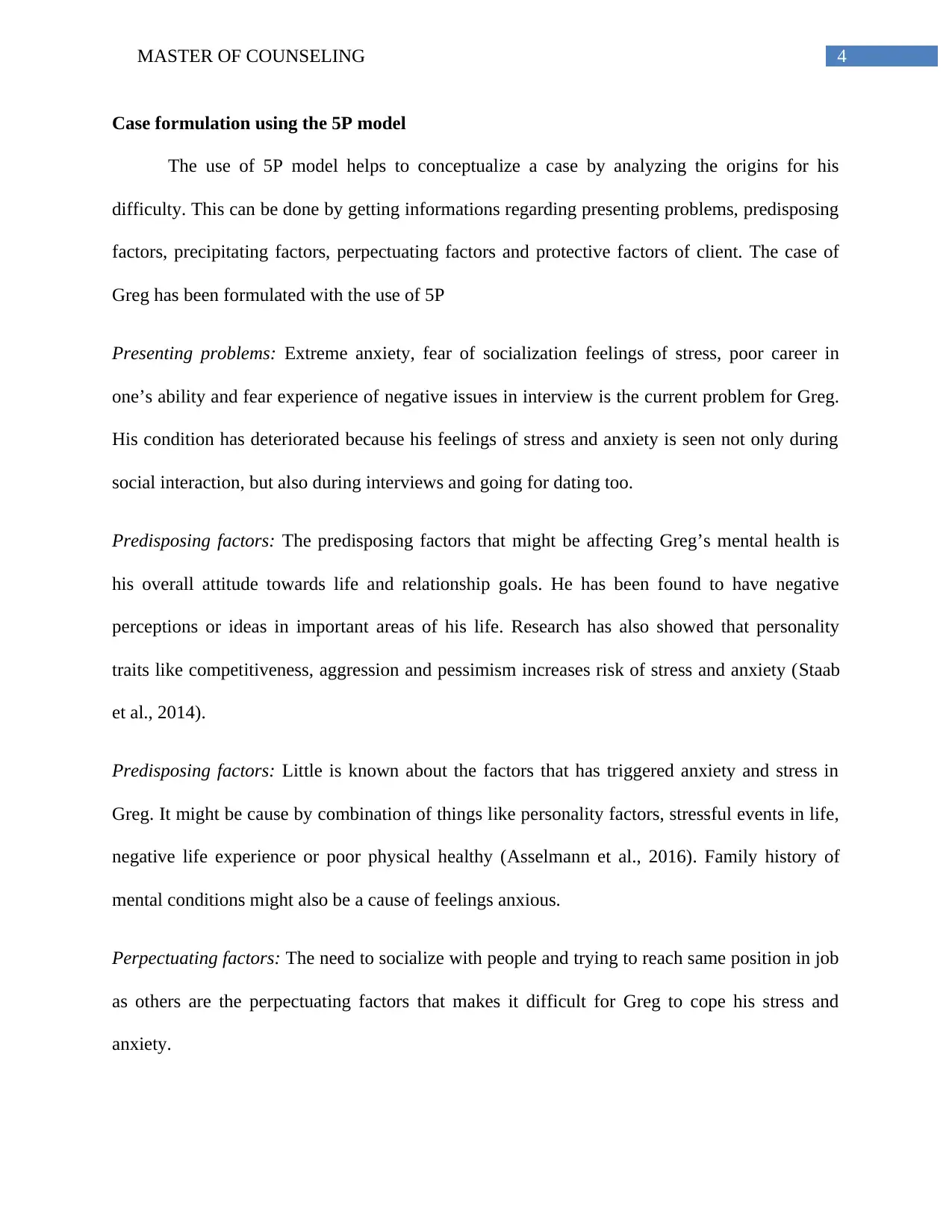
4MASTER OF COUNSELING
Case formulation using the 5P model
The use of 5P model helps to conceptualize a case by analyzing the origins for his
difficulty. This can be done by getting informations regarding presenting problems, predisposing
factors, precipitating factors, perpectuating factors and protective factors of client. The case of
Greg has been formulated with the use of 5P
Presenting problems: Extreme anxiety, fear of socialization feelings of stress, poor career in
one’s ability and fear experience of negative issues in interview is the current problem for Greg.
His condition has deteriorated because his feelings of stress and anxiety is seen not only during
social interaction, but also during interviews and going for dating too.
Predisposing factors: The predisposing factors that might be affecting Greg’s mental health is
his overall attitude towards life and relationship goals. He has been found to have negative
perceptions or ideas in important areas of his life. Research has also showed that personality
traits like competitiveness, aggression and pessimism increases risk of stress and anxiety (Staab
et al., 2014).
Predisposing factors: Little is known about the factors that has triggered anxiety and stress in
Greg. It might be cause by combination of things like personality factors, stressful events in life,
negative life experience or poor physical healthy (Asselmann et al., 2016). Family history of
mental conditions might also be a cause of feelings anxious.
Perpectuating factors: The need to socialize with people and trying to reach same position in job
as others are the perpectuating factors that makes it difficult for Greg to cope his stress and
anxiety.
Case formulation using the 5P model
The use of 5P model helps to conceptualize a case by analyzing the origins for his
difficulty. This can be done by getting informations regarding presenting problems, predisposing
factors, precipitating factors, perpectuating factors and protective factors of client. The case of
Greg has been formulated with the use of 5P
Presenting problems: Extreme anxiety, fear of socialization feelings of stress, poor career in
one’s ability and fear experience of negative issues in interview is the current problem for Greg.
His condition has deteriorated because his feelings of stress and anxiety is seen not only during
social interaction, but also during interviews and going for dating too.
Predisposing factors: The predisposing factors that might be affecting Greg’s mental health is
his overall attitude towards life and relationship goals. He has been found to have negative
perceptions or ideas in important areas of his life. Research has also showed that personality
traits like competitiveness, aggression and pessimism increases risk of stress and anxiety (Staab
et al., 2014).
Predisposing factors: Little is known about the factors that has triggered anxiety and stress in
Greg. It might be cause by combination of things like personality factors, stressful events in life,
negative life experience or poor physical healthy (Asselmann et al., 2016). Family history of
mental conditions might also be a cause of feelings anxious.
Perpectuating factors: The need to socialize with people and trying to reach same position in job
as others are the perpectuating factors that makes it difficult for Greg to cope his stress and
anxiety.

5MASTER OF COUNSELING
Protective factors: Protective factor is related to the support of the family, individual or the
wider community in supporting patients to deal with stressful events. In case of Greg, no such
protective factors exist who support him in dealing with the problem.
Discussion of treatment options and rationale for chosen treatment
The main issue found in Greg is extreme anxiety and there are many treatment options
available to address the issues. This includes pharmacological interventions, cognitive behavioral
therapy, residential treatment or rehabilitation and complementary and alternative treatments.
Baldwin et al., (2014) discussed regarding different evidence based pharmacological treatment
available for anxiety disorders. Several classes of antidepressant drugs has been found effective
in patients with anxiety disorders, however there is low evidence to prove the efficacy these
drugs for treatment of patients with mild forms of anxiety. Secondly, many self-help and
complementary approaches such as use of internet based educational sources is also preferred by
some patients due to suboptimal effect of pharmacological or psychological treatment. The
review of evidence based studies in this area has shown that efficacy of self-help group is high
only when detailed instruction is followed in use of self-help manuals (Baldwin et al., 2014).
Management of acute anxiety is also done by pharmacological or psychological treatments. For
instance, a comparative study analyzed cognitive behavioral therapy and psychodynamic therapy
in the treatment of stress disorders showed that both approach is equally beneficial in reducing
symptoms of anxiety iin patients however cost effectiveness of both needed to determined when
deciding to chose any one of the treatment options for a patents (Levi et al. 2016). Research also
showed that psychological treatments can be combined with drugs like clomipramine when more
efficacy is needed in short time (Baldwin et al., 2014).
Protective factors: Protective factor is related to the support of the family, individual or the
wider community in supporting patients to deal with stressful events. In case of Greg, no such
protective factors exist who support him in dealing with the problem.
Discussion of treatment options and rationale for chosen treatment
The main issue found in Greg is extreme anxiety and there are many treatment options
available to address the issues. This includes pharmacological interventions, cognitive behavioral
therapy, residential treatment or rehabilitation and complementary and alternative treatments.
Baldwin et al., (2014) discussed regarding different evidence based pharmacological treatment
available for anxiety disorders. Several classes of antidepressant drugs has been found effective
in patients with anxiety disorders, however there is low evidence to prove the efficacy these
drugs for treatment of patients with mild forms of anxiety. Secondly, many self-help and
complementary approaches such as use of internet based educational sources is also preferred by
some patients due to suboptimal effect of pharmacological or psychological treatment. The
review of evidence based studies in this area has shown that efficacy of self-help group is high
only when detailed instruction is followed in use of self-help manuals (Baldwin et al., 2014).
Management of acute anxiety is also done by pharmacological or psychological treatments. For
instance, a comparative study analyzed cognitive behavioral therapy and psychodynamic therapy
in the treatment of stress disorders showed that both approach is equally beneficial in reducing
symptoms of anxiety iin patients however cost effectiveness of both needed to determined when
deciding to chose any one of the treatment options for a patents (Levi et al. 2016). Research also
showed that psychological treatments can be combined with drugs like clomipramine when more
efficacy is needed in short time (Baldwin et al., 2014).
⊘ This is a preview!⊘
Do you want full access?
Subscribe today to unlock all pages.

Trusted by 1+ million students worldwide
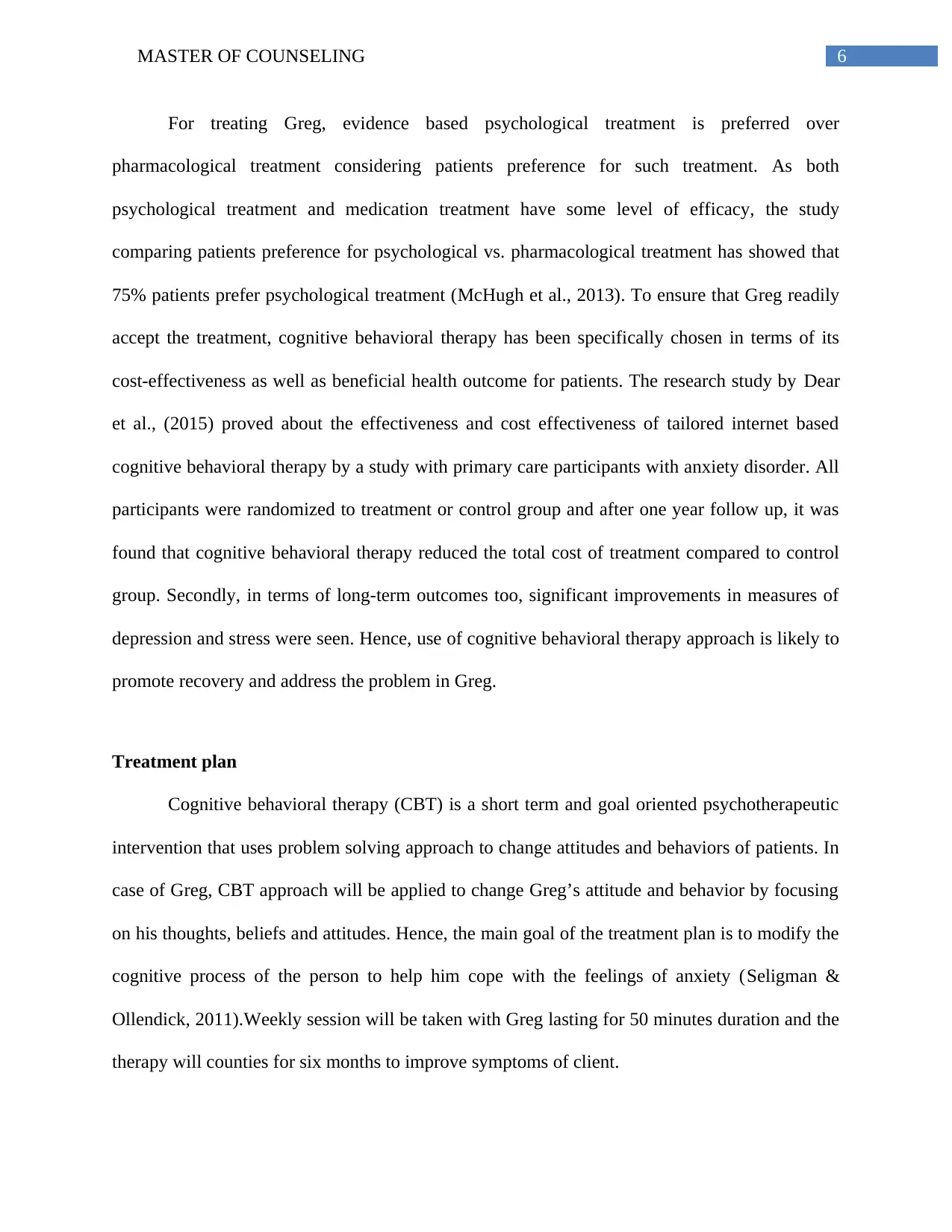
6MASTER OF COUNSELING
For treating Greg, evidence based psychological treatment is preferred over
pharmacological treatment considering patients preference for such treatment. As both
psychological treatment and medication treatment have some level of efficacy, the study
comparing patients preference for psychological vs. pharmacological treatment has showed that
75% patients prefer psychological treatment (McHugh et al., 2013). To ensure that Greg readily
accept the treatment, cognitive behavioral therapy has been specifically chosen in terms of its
cost-effectiveness as well as beneficial health outcome for patients. The research study by Dear
et al., (2015) proved about the effectiveness and cost effectiveness of tailored internet based
cognitive behavioral therapy by a study with primary care participants with anxiety disorder. All
participants were randomized to treatment or control group and after one year follow up, it was
found that cognitive behavioral therapy reduced the total cost of treatment compared to control
group. Secondly, in terms of long-term outcomes too, significant improvements in measures of
depression and stress were seen. Hence, use of cognitive behavioral therapy approach is likely to
promote recovery and address the problem in Greg.
Treatment plan
Cognitive behavioral therapy (CBT) is a short term and goal oriented psychotherapeutic
intervention that uses problem solving approach to change attitudes and behaviors of patients. In
case of Greg, CBT approach will be applied to change Greg’s attitude and behavior by focusing
on his thoughts, beliefs and attitudes. Hence, the main goal of the treatment plan is to modify the
cognitive process of the person to help him cope with the feelings of anxiety (Seligman &
Ollendick, 2011).Weekly session will be taken with Greg lasting for 50 minutes duration and the
therapy will counties for six months to improve symptoms of client.
For treating Greg, evidence based psychological treatment is preferred over
pharmacological treatment considering patients preference for such treatment. As both
psychological treatment and medication treatment have some level of efficacy, the study
comparing patients preference for psychological vs. pharmacological treatment has showed that
75% patients prefer psychological treatment (McHugh et al., 2013). To ensure that Greg readily
accept the treatment, cognitive behavioral therapy has been specifically chosen in terms of its
cost-effectiveness as well as beneficial health outcome for patients. The research study by Dear
et al., (2015) proved about the effectiveness and cost effectiveness of tailored internet based
cognitive behavioral therapy by a study with primary care participants with anxiety disorder. All
participants were randomized to treatment or control group and after one year follow up, it was
found that cognitive behavioral therapy reduced the total cost of treatment compared to control
group. Secondly, in terms of long-term outcomes too, significant improvements in measures of
depression and stress were seen. Hence, use of cognitive behavioral therapy approach is likely to
promote recovery and address the problem in Greg.
Treatment plan
Cognitive behavioral therapy (CBT) is a short term and goal oriented psychotherapeutic
intervention that uses problem solving approach to change attitudes and behaviors of patients. In
case of Greg, CBT approach will be applied to change Greg’s attitude and behavior by focusing
on his thoughts, beliefs and attitudes. Hence, the main goal of the treatment plan is to modify the
cognitive process of the person to help him cope with the feelings of anxiety (Seligman &
Ollendick, 2011).Weekly session will be taken with Greg lasting for 50 minutes duration and the
therapy will counties for six months to improve symptoms of client.
Paraphrase This Document
Need a fresh take? Get an instant paraphrase of this document with our AI Paraphraser
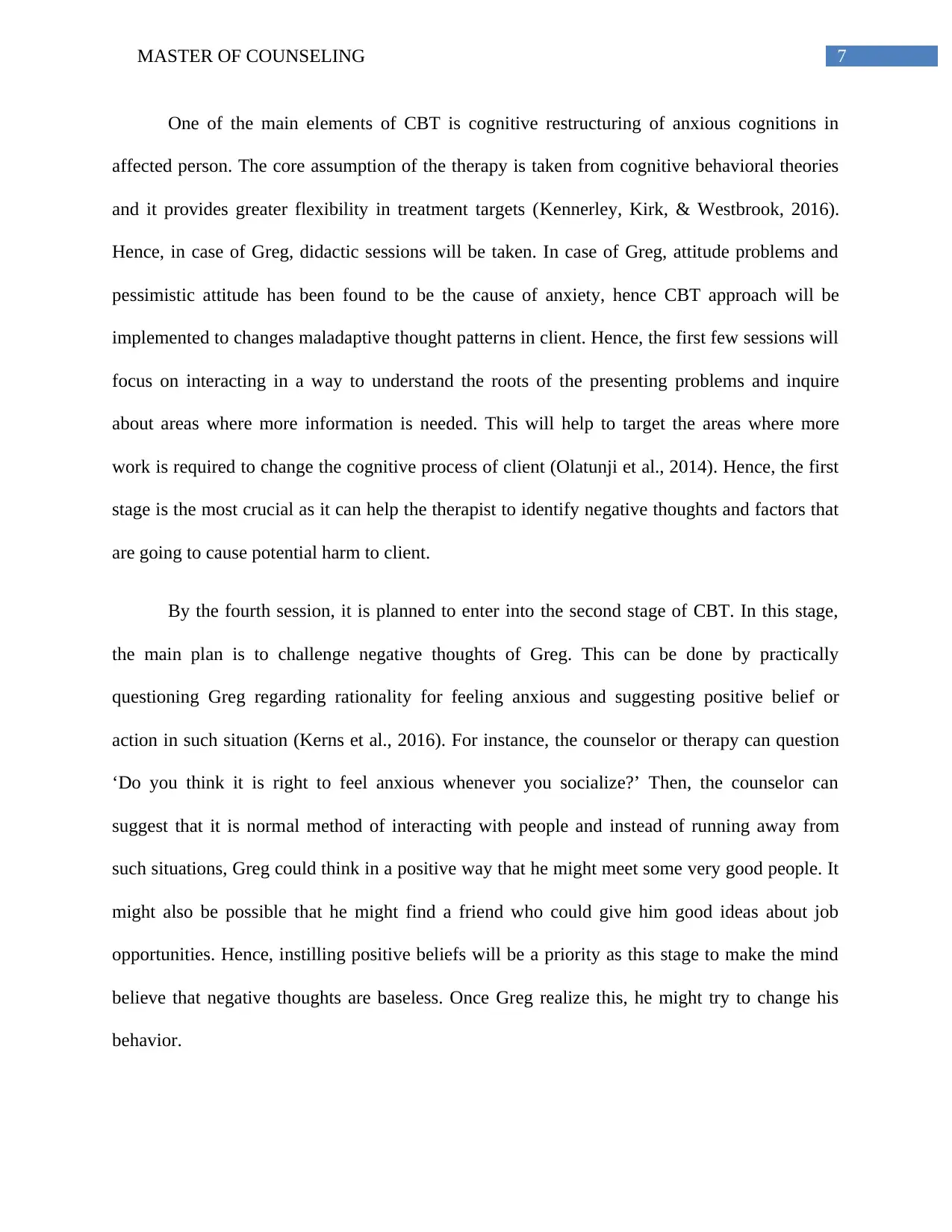
7MASTER OF COUNSELING
One of the main elements of CBT is cognitive restructuring of anxious cognitions in
affected person. The core assumption of the therapy is taken from cognitive behavioral theories
and it provides greater flexibility in treatment targets (Kennerley, Kirk, & Westbrook, 2016).
Hence, in case of Greg, didactic sessions will be taken. In case of Greg, attitude problems and
pessimistic attitude has been found to be the cause of anxiety, hence CBT approach will be
implemented to changes maladaptive thought patterns in client. Hence, the first few sessions will
focus on interacting in a way to understand the roots of the presenting problems and inquire
about areas where more information is needed. This will help to target the areas where more
work is required to change the cognitive process of client (Olatunji et al., 2014). Hence, the first
stage is the most crucial as it can help the therapist to identify negative thoughts and factors that
are going to cause potential harm to client.
By the fourth session, it is planned to enter into the second stage of CBT. In this stage,
the main plan is to challenge negative thoughts of Greg. This can be done by practically
questioning Greg regarding rationality for feeling anxious and suggesting positive belief or
action in such situation (Kerns et al., 2016). For instance, the counselor or therapy can question
‘Do you think it is right to feel anxious whenever you socialize?’ Then, the counselor can
suggest that it is normal method of interacting with people and instead of running away from
such situations, Greg could think in a positive way that he might meet some very good people. It
might also be possible that he might find a friend who could give him good ideas about job
opportunities. Hence, instilling positive beliefs will be a priority as this stage to make the mind
believe that negative thoughts are baseless. Once Greg realize this, he might try to change his
behavior.
One of the main elements of CBT is cognitive restructuring of anxious cognitions in
affected person. The core assumption of the therapy is taken from cognitive behavioral theories
and it provides greater flexibility in treatment targets (Kennerley, Kirk, & Westbrook, 2016).
Hence, in case of Greg, didactic sessions will be taken. In case of Greg, attitude problems and
pessimistic attitude has been found to be the cause of anxiety, hence CBT approach will be
implemented to changes maladaptive thought patterns in client. Hence, the first few sessions will
focus on interacting in a way to understand the roots of the presenting problems and inquire
about areas where more information is needed. This will help to target the areas where more
work is required to change the cognitive process of client (Olatunji et al., 2014). Hence, the first
stage is the most crucial as it can help the therapist to identify negative thoughts and factors that
are going to cause potential harm to client.
By the fourth session, it is planned to enter into the second stage of CBT. In this stage,
the main plan is to challenge negative thoughts of Greg. This can be done by practically
questioning Greg regarding rationality for feeling anxious and suggesting positive belief or
action in such situation (Kerns et al., 2016). For instance, the counselor or therapy can question
‘Do you think it is right to feel anxious whenever you socialize?’ Then, the counselor can
suggest that it is normal method of interacting with people and instead of running away from
such situations, Greg could think in a positive way that he might meet some very good people. It
might also be possible that he might find a friend who could give him good ideas about job
opportunities. Hence, instilling positive beliefs will be a priority as this stage to make the mind
believe that negative thoughts are baseless. Once Greg realize this, he might try to change his
behavior.
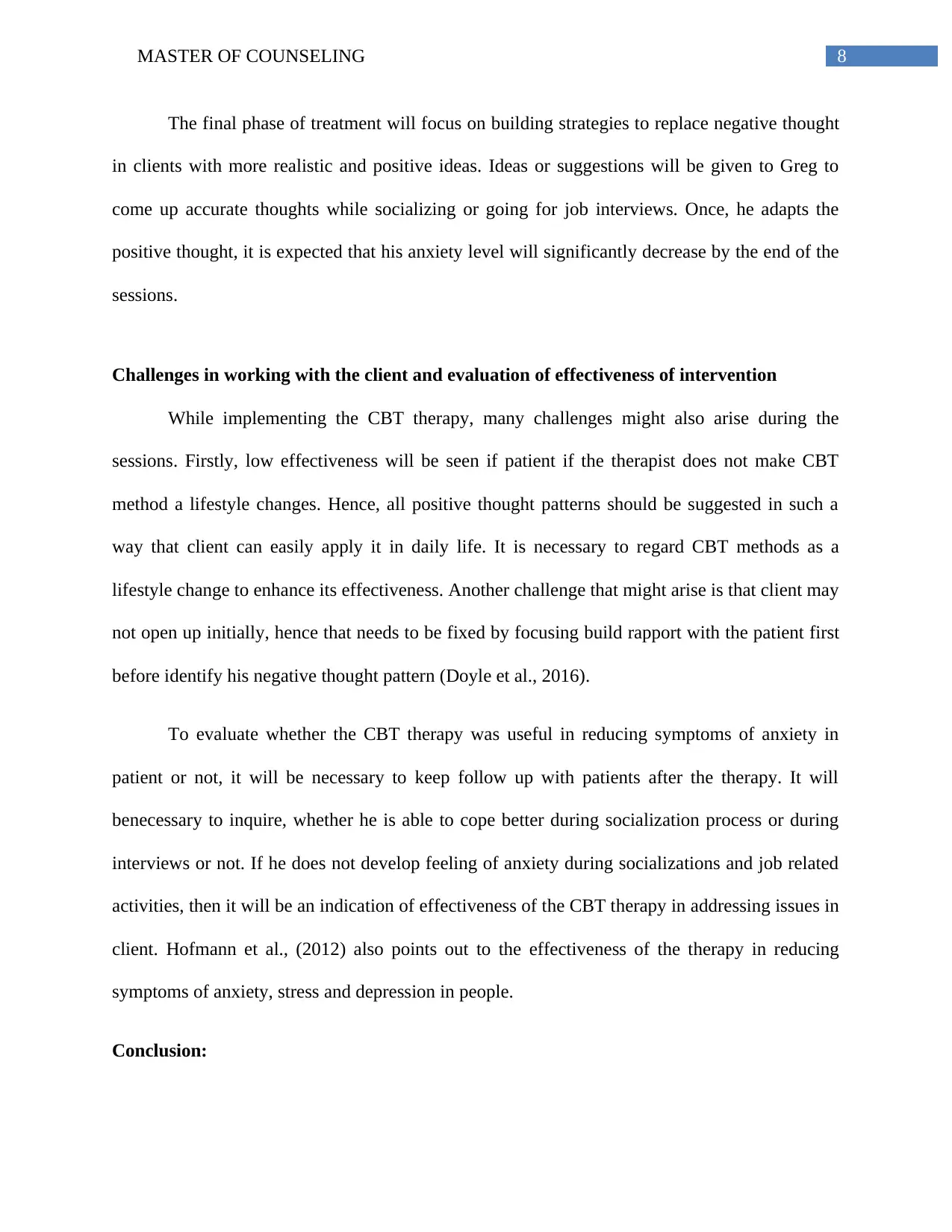
8MASTER OF COUNSELING
The final phase of treatment will focus on building strategies to replace negative thought
in clients with more realistic and positive ideas. Ideas or suggestions will be given to Greg to
come up accurate thoughts while socializing or going for job interviews. Once, he adapts the
positive thought, it is expected that his anxiety level will significantly decrease by the end of the
sessions.
Challenges in working with the client and evaluation of effectiveness of intervention
While implementing the CBT therapy, many challenges might also arise during the
sessions. Firstly, low effectiveness will be seen if patient if the therapist does not make CBT
method a lifestyle changes. Hence, all positive thought patterns should be suggested in such a
way that client can easily apply it in daily life. It is necessary to regard CBT methods as a
lifestyle change to enhance its effectiveness. Another challenge that might arise is that client may
not open up initially, hence that needs to be fixed by focusing build rapport with the patient first
before identify his negative thought pattern (Doyle et al., 2016).
To evaluate whether the CBT therapy was useful in reducing symptoms of anxiety in
patient or not, it will be necessary to keep follow up with patients after the therapy. It will
benecessary to inquire, whether he is able to cope better during socialization process or during
interviews or not. If he does not develop feeling of anxiety during socializations and job related
activities, then it will be an indication of effectiveness of the CBT therapy in addressing issues in
client. Hofmann et al., (2012) also points out to the effectiveness of the therapy in reducing
symptoms of anxiety, stress and depression in people.
Conclusion:
The final phase of treatment will focus on building strategies to replace negative thought
in clients with more realistic and positive ideas. Ideas or suggestions will be given to Greg to
come up accurate thoughts while socializing or going for job interviews. Once, he adapts the
positive thought, it is expected that his anxiety level will significantly decrease by the end of the
sessions.
Challenges in working with the client and evaluation of effectiveness of intervention
While implementing the CBT therapy, many challenges might also arise during the
sessions. Firstly, low effectiveness will be seen if patient if the therapist does not make CBT
method a lifestyle changes. Hence, all positive thought patterns should be suggested in such a
way that client can easily apply it in daily life. It is necessary to regard CBT methods as a
lifestyle change to enhance its effectiveness. Another challenge that might arise is that client may
not open up initially, hence that needs to be fixed by focusing build rapport with the patient first
before identify his negative thought pattern (Doyle et al., 2016).
To evaluate whether the CBT therapy was useful in reducing symptoms of anxiety in
patient or not, it will be necessary to keep follow up with patients after the therapy. It will
benecessary to inquire, whether he is able to cope better during socialization process or during
interviews or not. If he does not develop feeling of anxiety during socializations and job related
activities, then it will be an indication of effectiveness of the CBT therapy in addressing issues in
client. Hofmann et al., (2012) also points out to the effectiveness of the therapy in reducing
symptoms of anxiety, stress and depression in people.
Conclusion:
⊘ This is a preview!⊘
Do you want full access?
Subscribe today to unlock all pages.

Trusted by 1+ million students worldwide
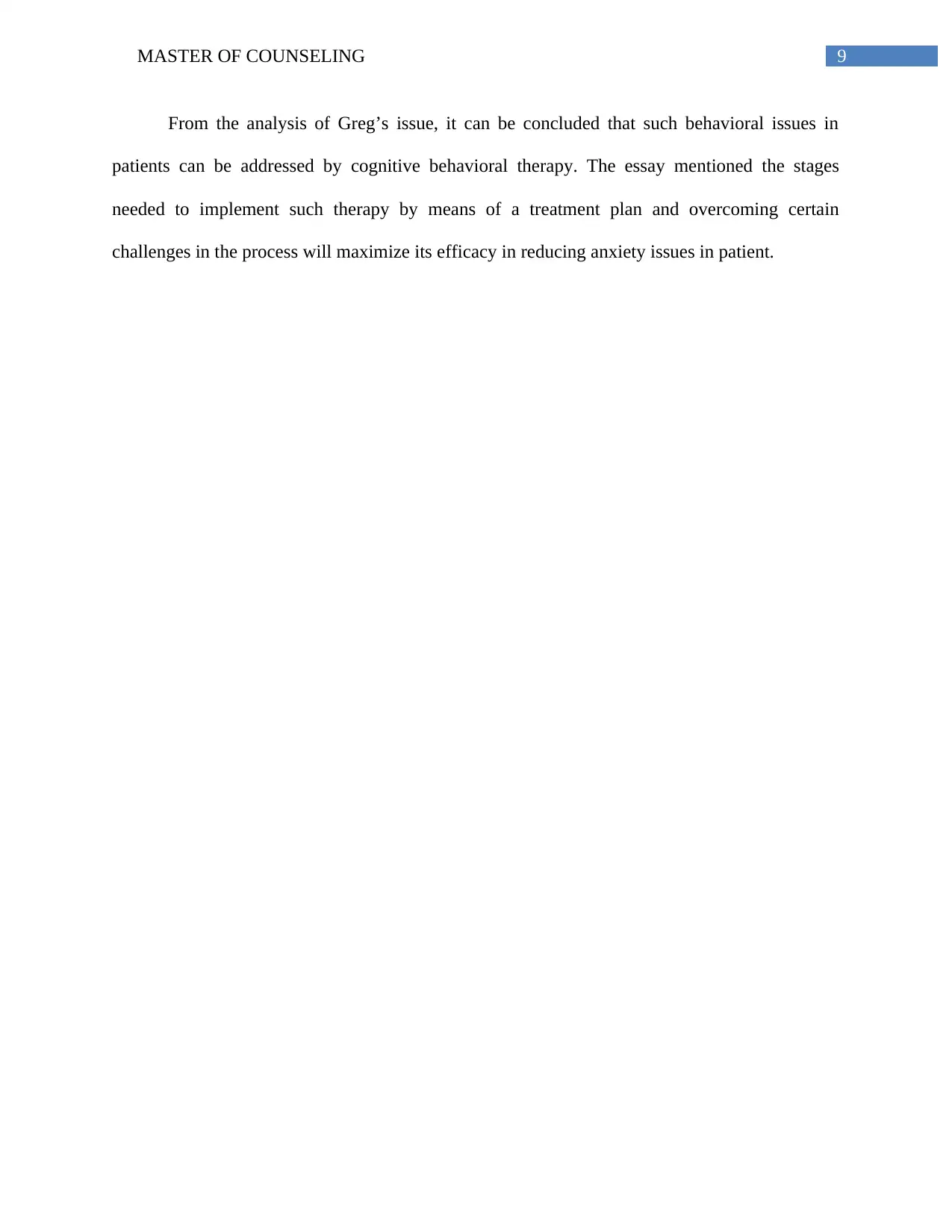
9MASTER OF COUNSELING
From the analysis of Greg’s issue, it can be concluded that such behavioral issues in
patients can be addressed by cognitive behavioral therapy. The essay mentioned the stages
needed to implement such therapy by means of a treatment plan and overcoming certain
challenges in the process will maximize its efficacy in reducing anxiety issues in patient.
From the analysis of Greg’s issue, it can be concluded that such behavioral issues in
patients can be addressed by cognitive behavioral therapy. The essay mentioned the stages
needed to implement such therapy by means of a treatment plan and overcoming certain
challenges in the process will maximize its efficacy in reducing anxiety issues in patient.
Paraphrase This Document
Need a fresh take? Get an instant paraphrase of this document with our AI Paraphraser

10MASTER OF COUNSELING
Reference
Asselmann, E., Wittchen, H. U., Lieb, R., Höfler, M., & Beesdo-Baum, K. (2016). Does low
coping efficacy mediate the association between negative life events and incident
psychopathology? A prospective-longitudinal community study among adolescents and
young adults. Epidemiology and psychiatric sciences, 25(2), 171-180.
Baldwin, D. S., Anderson, I. M., Nutt, D. J., Allgulander, C., Bandelow, B., den Boer, J. A., ... &
Malizia, A. (2014). Evidence-based pharmacological treatment of anxiety disorders, post-
traumatic stress disorder and obsessive-compulsive disorder: a revision of the 2005
guidelines from the British Association for Psychopharmacology. Journal of
Psychopharmacology, 28(5), 403-439.
Dear, B. F., Zou, J. B., Ali, S., Lorian, C. N., Johnston, L., Sheehan, J., ... & Titov, N. (2015).
Clinical and cost-effectiveness of therapist-guided internet-delivered cognitive behavior
therapy for older adults with symptoms of anxiety: a randomized controlled
trial. Behavior therapy, 46(2), 206-217.
Doyle, C., Dunt, D., Ames, D., Fearn, M., You, E. C., & Bhar, S. (2016). Study protocol for a
randomized controlled trial of telephone-delivered cognitive behavior therapy compared
with befriending for treating depression and anxiety in older adults with
COPD. International journal of chronic obstructive pulmonary disease, 11, 327.
Hofmann, S. G., Asnaani, A., Vonk, I. J., Sawyer, A. T., & Fang, A. (2012). The efficacy of
cognitive behavioral therapy: A review of meta-analyses. Cognitive therapy and
research, 36(5), 427-440.
Reference
Asselmann, E., Wittchen, H. U., Lieb, R., Höfler, M., & Beesdo-Baum, K. (2016). Does low
coping efficacy mediate the association between negative life events and incident
psychopathology? A prospective-longitudinal community study among adolescents and
young adults. Epidemiology and psychiatric sciences, 25(2), 171-180.
Baldwin, D. S., Anderson, I. M., Nutt, D. J., Allgulander, C., Bandelow, B., den Boer, J. A., ... &
Malizia, A. (2014). Evidence-based pharmacological treatment of anxiety disorders, post-
traumatic stress disorder and obsessive-compulsive disorder: a revision of the 2005
guidelines from the British Association for Psychopharmacology. Journal of
Psychopharmacology, 28(5), 403-439.
Dear, B. F., Zou, J. B., Ali, S., Lorian, C. N., Johnston, L., Sheehan, J., ... & Titov, N. (2015).
Clinical and cost-effectiveness of therapist-guided internet-delivered cognitive behavior
therapy for older adults with symptoms of anxiety: a randomized controlled
trial. Behavior therapy, 46(2), 206-217.
Doyle, C., Dunt, D., Ames, D., Fearn, M., You, E. C., & Bhar, S. (2016). Study protocol for a
randomized controlled trial of telephone-delivered cognitive behavior therapy compared
with befriending for treating depression and anxiety in older adults with
COPD. International journal of chronic obstructive pulmonary disease, 11, 327.
Hofmann, S. G., Asnaani, A., Vonk, I. J., Sawyer, A. T., & Fang, A. (2012). The efficacy of
cognitive behavioral therapy: A review of meta-analyses. Cognitive therapy and
research, 36(5), 427-440.
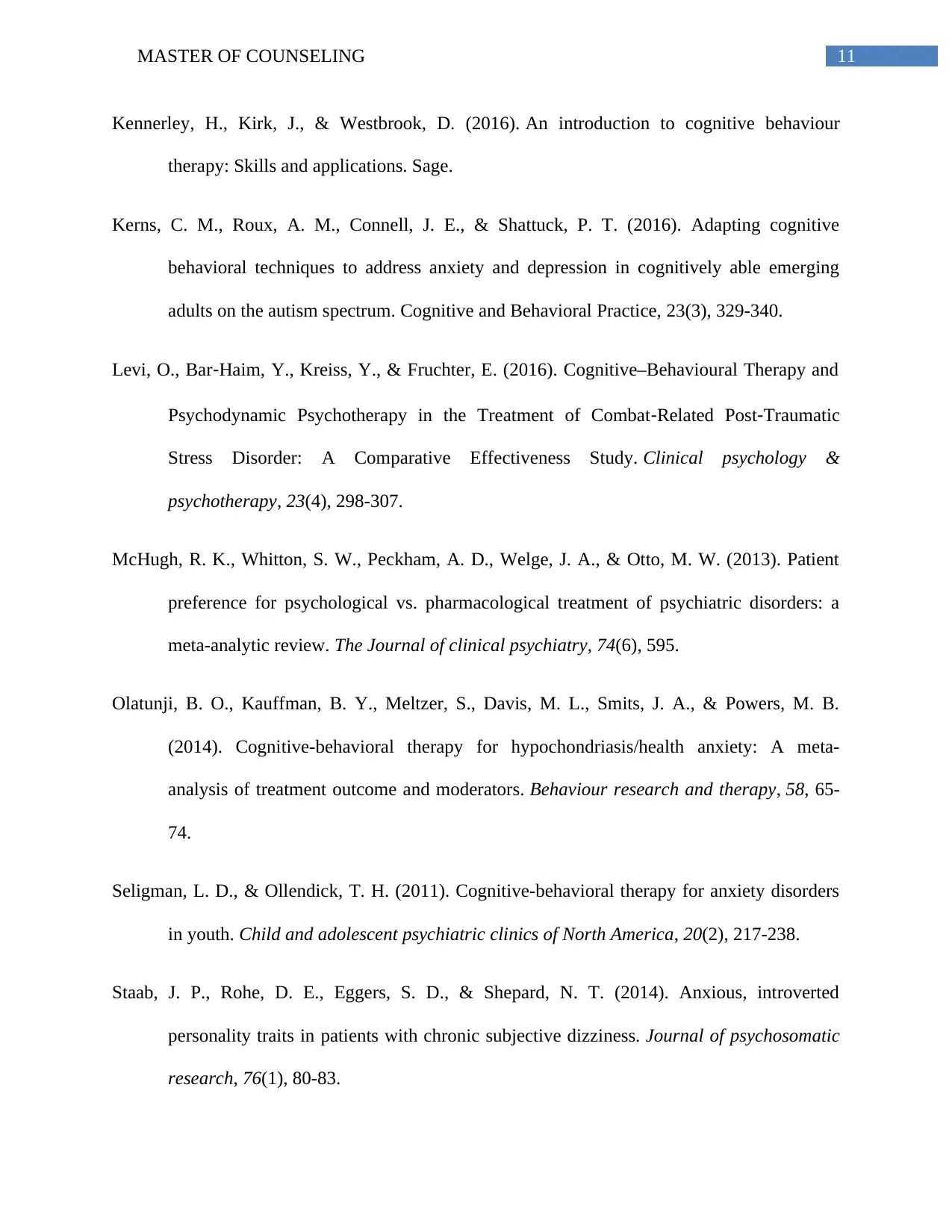
11MASTER OF COUNSELING
Kennerley, H., Kirk, J., & Westbrook, D. (2016). An introduction to cognitive behaviour
therapy: Skills and applications. Sage.
Kerns, C. M., Roux, A. M., Connell, J. E., & Shattuck, P. T. (2016). Adapting cognitive
behavioral techniques to address anxiety and depression in cognitively able emerging
adults on the autism spectrum. Cognitive and Behavioral Practice, 23(3), 329-340.
Levi, O., Bar‐Haim, Y., Kreiss, Y., & Fruchter, E. (2016). Cognitive–Behavioural Therapy and
Psychodynamic Psychotherapy in the Treatment of Combat‐Related Post‐Traumatic
Stress Disorder: A Comparative Effectiveness Study. Clinical psychology &
psychotherapy, 23(4), 298-307.
McHugh, R. K., Whitton, S. W., Peckham, A. D., Welge, J. A., & Otto, M. W. (2013). Patient
preference for psychological vs. pharmacological treatment of psychiatric disorders: a
meta-analytic review. The Journal of clinical psychiatry, 74(6), 595.
Olatunji, B. O., Kauffman, B. Y., Meltzer, S., Davis, M. L., Smits, J. A., & Powers, M. B.
(2014). Cognitive-behavioral therapy for hypochondriasis/health anxiety: A meta-
analysis of treatment outcome and moderators. Behaviour research and therapy, 58, 65-
74.
Seligman, L. D., & Ollendick, T. H. (2011). Cognitive-behavioral therapy for anxiety disorders
in youth. Child and adolescent psychiatric clinics of North America, 20(2), 217-238.
Staab, J. P., Rohe, D. E., Eggers, S. D., & Shepard, N. T. (2014). Anxious, introverted
personality traits in patients with chronic subjective dizziness. Journal of psychosomatic
research, 76(1), 80-83.
Kennerley, H., Kirk, J., & Westbrook, D. (2016). An introduction to cognitive behaviour
therapy: Skills and applications. Sage.
Kerns, C. M., Roux, A. M., Connell, J. E., & Shattuck, P. T. (2016). Adapting cognitive
behavioral techniques to address anxiety and depression in cognitively able emerging
adults on the autism spectrum. Cognitive and Behavioral Practice, 23(3), 329-340.
Levi, O., Bar‐Haim, Y., Kreiss, Y., & Fruchter, E. (2016). Cognitive–Behavioural Therapy and
Psychodynamic Psychotherapy in the Treatment of Combat‐Related Post‐Traumatic
Stress Disorder: A Comparative Effectiveness Study. Clinical psychology &
psychotherapy, 23(4), 298-307.
McHugh, R. K., Whitton, S. W., Peckham, A. D., Welge, J. A., & Otto, M. W. (2013). Patient
preference for psychological vs. pharmacological treatment of psychiatric disorders: a
meta-analytic review. The Journal of clinical psychiatry, 74(6), 595.
Olatunji, B. O., Kauffman, B. Y., Meltzer, S., Davis, M. L., Smits, J. A., & Powers, M. B.
(2014). Cognitive-behavioral therapy for hypochondriasis/health anxiety: A meta-
analysis of treatment outcome and moderators. Behaviour research and therapy, 58, 65-
74.
Seligman, L. D., & Ollendick, T. H. (2011). Cognitive-behavioral therapy for anxiety disorders
in youth. Child and adolescent psychiatric clinics of North America, 20(2), 217-238.
Staab, J. P., Rohe, D. E., Eggers, S. D., & Shepard, N. T. (2014). Anxious, introverted
personality traits in patients with chronic subjective dizziness. Journal of psychosomatic
research, 76(1), 80-83.
⊘ This is a preview!⊘
Do you want full access?
Subscribe today to unlock all pages.

Trusted by 1+ million students worldwide
1 out of 13
Related Documents
Your All-in-One AI-Powered Toolkit for Academic Success.
+13062052269
info@desklib.com
Available 24*7 on WhatsApp / Email
![[object Object]](/_next/static/media/star-bottom.7253800d.svg)
Unlock your academic potential
Copyright © 2020–2025 A2Z Services. All Rights Reserved. Developed and managed by ZUCOL.



